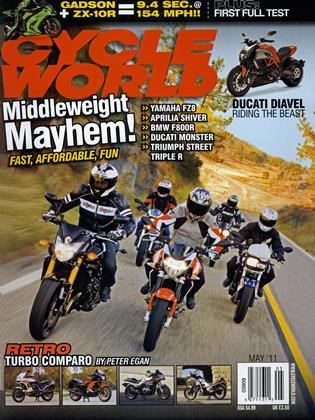THE FIRST Fire-Breather
Kawasaki Z1-R TC II Turbo
Nothing is harder to change than character.
And no motorcycle's character was ever stronger or more distinct than that of the first turbocharged Kawasaki Z1-R.
As a contemporary road test described it: "There's just one sensible thing to do with a Kawasaki Z1-R TC II turbo—chain it to the floor of your garage and feed it a little raw meat now and then. Little children and puppy dogs will do nicely." It may be 31 years later, but you'd still be advised to keep kids and pets away.
By the late 1970s, Kawasaki's Z1 was finally seeing its performance crown challenged. Serious Open-class competitors— from Honda's CBX to the Yamaha XS1100 to Suzuki's GS1000—'were in development and would change the performance landscape forever when they emerged in 1978 and 1979. To maintain a position in the highpower spotlight while working on more conventional solutions, Kawasaki's stateside arm did what everyone truly desperate for easy horsepower has always done: add boost.
The Z1 -R TC was not a factory bike—it was merely closely tied to Kawasaki. Sold exclusively in U.S. Kawasaki dealers for the 1978 and 1979 model years, it began as a stock Z1-R and was modified by a company called Turbo Cycle Corporation (hence the TC in the bike's name), headed by Kawasaki's former marketing director, Alan Masek. The modifications consisted chiefly of bolting on an American TurboPak turbo kit and, for the 1979 model year, adding a swoopy blackand-rainbow-stripe paint job by famous graphic designer Molly. Along with the paint job, the 79 version was readily recognizable by the spider-like exhaust manifold replacing the log-style version used on the 1978 build. On the beautifully original version we rode, the exhaust had turned more colors than a titanium heat shield, a rainbow from gold to purple that complemented the bodywork stripe well—just the first clue that this bike was a lot out of the ordinary.
The second is that the engine is hardstarting, with a fine line between squirting in just enough gas via the single carb's
accelerator pump and too much; you can end up with fouled plugs if you're not careful and knowledgeable. The non-muffler puffs smoke from the initially rich mixture and rasps an exhaust note that's hard to believe was ever legal anywhere.
But on the road, engine performance smoothes, and as the boost builds (with noticeable lag) from 5000 rpm on up, the Z1-R TC squirts forward as none of its contemporaries ever dreamed. One 1970s road test measured a 10.90-second, 130-mph quarter-mile performance, very believable after riding this 31-year-old example—particularly since the wastegate setting could be dialed higher by anyone with a flat-blade screwdriver. Buyers were warned then that sustained high-speed running could melt the engine, that 96-octane gas was recommended, and that turning the boost screw higher could harm internal engine parts—such as twisting the Z1-R's non-welded, pressedtogether crankshaft into a pretzel.
But perhaps the most important thing they should have been told is this: Z1 brakes are totally inadequate for this level of performance. A four-finger death grip is required to slow this beast quickly, and you immediately get the sense that you will be the raw-meat offering if you romp too hard and too long on this time-warp machine. The factory turbos to follow would be ever so much more refined and well-rounded than this first production turbo, but they would never have its visceral appeal—or seem more willing to offer you to the sausage creature.
—Steve Anderson
 View Full Issue
View Full Issue









